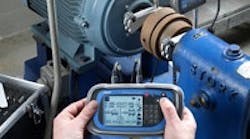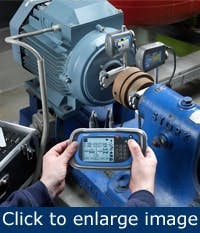Bearing maintenance tools enhance sustainability with rotating equipment
Energy-conserving rotating equipment components and advanced maintenance technologies can help an enterprise meet its environmental objectives and achieve greater overall sustainability. Benefits include more efficient use of energy and raw materials, reduced waste in manufacturing processes, minimized environmental assaults, and reduced carbon and other emissions.
Plant managers, maintenance professionals and others charged with improving sustainability have a greater range of options available than ever before. These include rolling bearings and bearing units that are optimized for low-friction, energy-conserving operation, highly accurate lubricant-dispensing systems and laser-equipped alignment instruments.
Ultra-efficient rotating components
Shaft bearings directly affect a plant’s productivity, energy use and overall sustainability. As more attention has focused on sustainability during the past decade, technical innovations result in new generations of highly efficient rolling bearings.
One example is energy-efficient deep-groove ball bearings designed for light- and medium-load applications in electric motors, pumps, conveyors and fans. Equipped with an optimized internal geometry, these bearings consume 30% to 50% less energy than standard deep-groove ball bearings in similar applications.
Their low-friction performance was confirmed by tests conducted on a 3-kW electric motor. The free running time of various bearings was measured after power to the motor was switched off. The energy-efficient bearings ran 50% longer after power shutdown than standard deep groove ball bearings.
Energy-efficient deep-groove ball bearings are shielded on both sides and equipped with a snap-type cage made of a temperature-resistant glass fiber-reinforced polymer. The bearings are lubricated with a low-noise, low-friction grease.
[pullquote]In addition, you can upgrade to lubricated-for-life bearing units designed for food-industry and related applications. These bearing units reduce grease consumption during the bearing’s lifecycle and prevent grease from entering the waste stream. In one case, a company in the northwestern United States replaced cast-iron pillow blocks with lubed-for-life bearing units on its multi-lane sorting machinery used for apple processing. The conventional pillow blocks had sustained rusting and lubricant washout and had a life expectancy of only three months. The new bearings featured corrosion-resistant composite housings.
After the test period proved successful, the company specified the lubed-for-life composite units as drop-in replacements for the conventional cast-iron units. The composite units feature specially coated insert bearings and stainless steel sealing components. They withstand high-pressure washdowns without purging grease and are lubricated with USDA-approved food-grade grease. Equipped with these bearing units, the upgraded apple sorters have operated for a full year without requiring any bearing-related service.
Studies estimate that, in a typical application, these lubed-for-life units save more than 100 oz. of grease per unit annually. Depending on the number of units, in a single year a plant can keep many thousands of ounces of grease out of the environment.
Waste-reducing lube dispensers
Most bearings require periodic relubrication. For reasons of productivity and sustainability, it’s important to follow correct lubrication practices and avoid underlubricating or overlubricating. Underlubrication can cause metal-to-metal contact between bearing components and eventual bearing failure. Overlubrication causes churning, which results in higher operating temperatures and lubricant degradation. On the macro level, excessive lubrication throughout a plant increases lubricant consumption and waste.
Automatic dispensing systems can keep lubricant usage under control. They deliver a steady flow of lubricant directly to machine points, supplying just the right amount of lubricant needed. One popular type of single-point lubricator is a self-contained, electromechanically driven unit consisting of a battery-operated motor and a lubricant canister. The canister can hold 250 ml of either grease or oil. When activated, the motor drives a piston that dispenses the lubricant at the preset user-selected rate. This single-point lubricator can be mounted remotely to lubricate bearings in areas with high temperatures or excessive vibration.
Higher-capacity, multi-point lubricators are intended for heavy-duty applications such as hot gas fans and calendar rolls in paper mills. These systems distribute grease or oil from a central canister through as many as eight feed lines.
Manual relubing is still the norm in many applications. It can be difficult, however, to measure the amount of grease injected using manual methods. Grease meters can provide a sustainable solution. They can measure grease quantities by volume or weight accurately and display the amounts on built-in screens. They’re usually compatible with a variety of grease guns and pumps.
Green lubricants
Lubricant formulation represents another sustainability issue. A growing number of biodegradable “green” greases are available for applications if environmental contamination is a concern. One such lubricant, a low-toxicity, synthetic ester oil-based grease, is designed for water treatment, irrigation, agricultural, forestry, construction, mining and other such applications.
The grease, intended for use in ball and roller bearings and spherical plain bearings, complies with government regulations on toxicity and biodegradability. It exhibits good performance in low-temperature startups and has superior corrosion-inhibiting properties.
High-accuracy alignment instruments
The shafts on rotating machinery must be aligned properly to maximize mechanical efficiency. Shaft misalignment and related problems impair productivity and consume additional resources. Advanced alignment technologies can improve and simplify the alignment process.
Figure 1. A handheld laser shaft alignment tool can provide real-time alignment values.
A laser-equipped shaft alignment tool, for example, displays live alignment values, simplifies making instant adjustments and corrections (Figure 1). This allows alignment to be completed more quickly than with traditional methods. The tool’s “soft foot” function verifies that machine mountings are stable and secure. The alignment values and settings in these units can be stored easily and uploaded via USB cable to a PC.
A major food and beverage manufacturer found that vibration analysis revealed that alignment problems were harming machine performance. The plant used laser alignment instruments to cut energy consumption by 8% in a large group of its pumps and motors. After the pumps and motors were aligned correctly, energy usage dropped by 30 kW per day, netting an annual savings of more than $28,000, as well as less unplanned downtime and spare parts consumption.
Misalignment also affects V-belt drives, synchronous belt drives and timing belts. It increases pulley and belt wear and consumes excessive energy. Specialized belt alignment instruments can help belts run more efficiently. One such instrument uses a laser and a receiver. The tool facilitates aligning pulleys of varying widths and with dissimilar faces, allowing belts to ride in pulley grooves. This reduces friction during operation.
Energy-saving induction heaters
Electrical power often is needed to install rotating equipment components, especially large bearings, housings, gear wheels and couplings. Modern versions of the electrically powered induction heater, a widely used device, are available with energy-conserving features. One line, for example, features advanced electronics and a dual-coil design. These devices can heat large bearings or other components weighing as much as 2,600 lb., consuming only 20 kVA of electricity — a 50% reduction compared with conventional induction heaters. Modern heaters have ergonomically designed yokes with a sliding arm, which allows users to load components without lifting and removing the yokes. The components are demagnetized automatically after the heating cycle is complete.
Paul Michalicka is a sales manager for SKF USA Inc. in Lansdale, Pennsylvania. He can be reached at [email protected] and (416) 299-2894.

